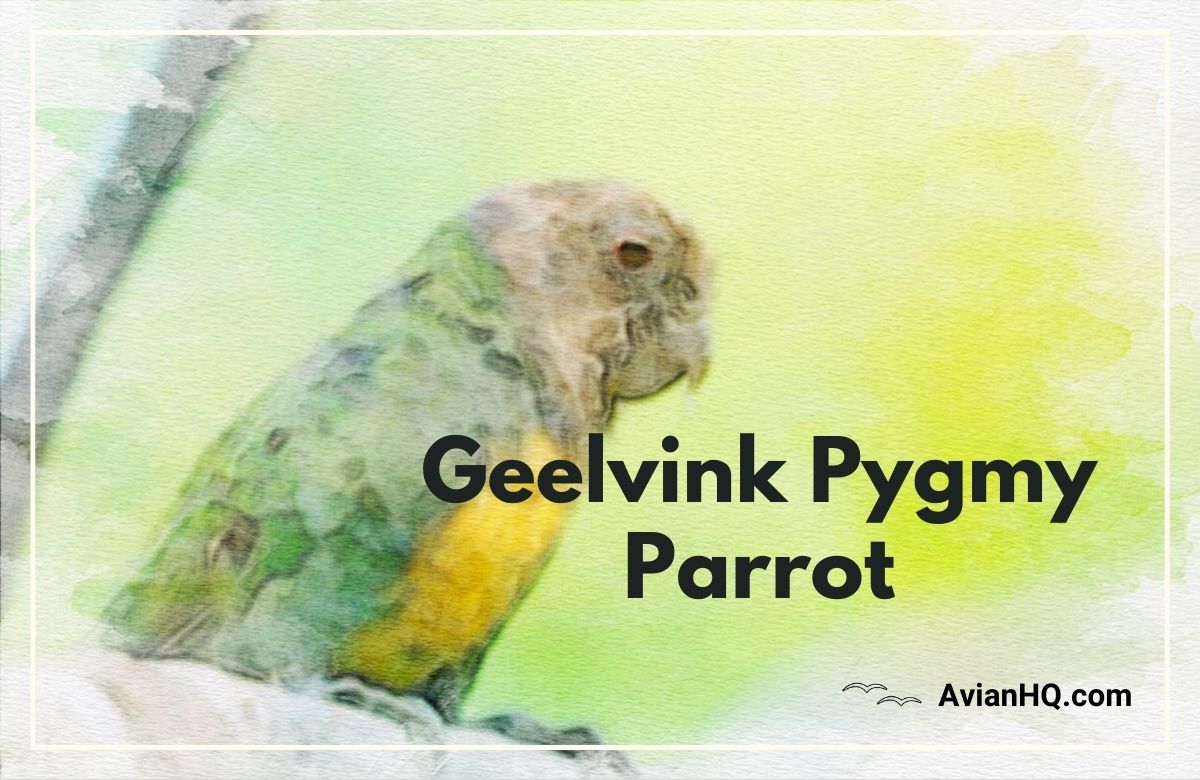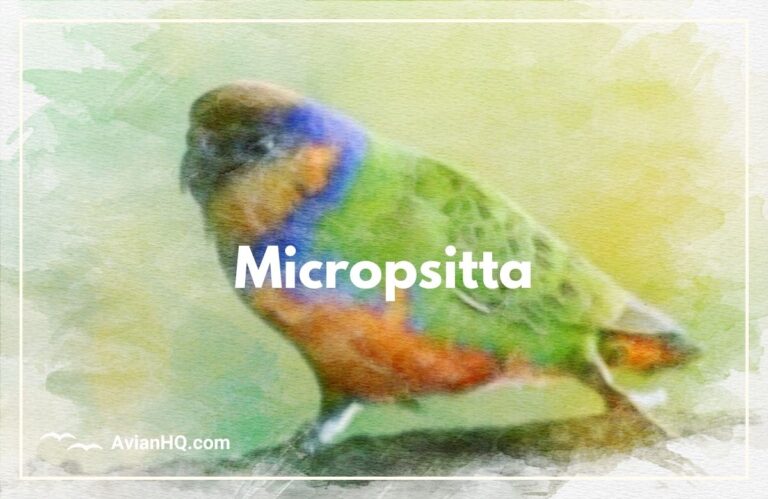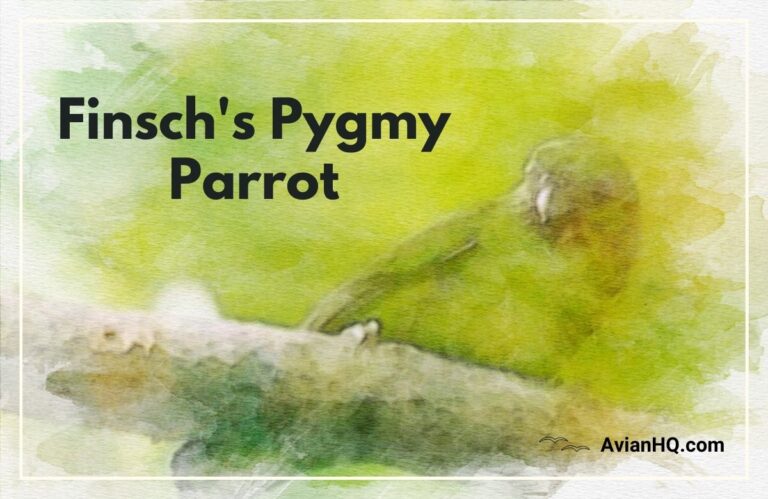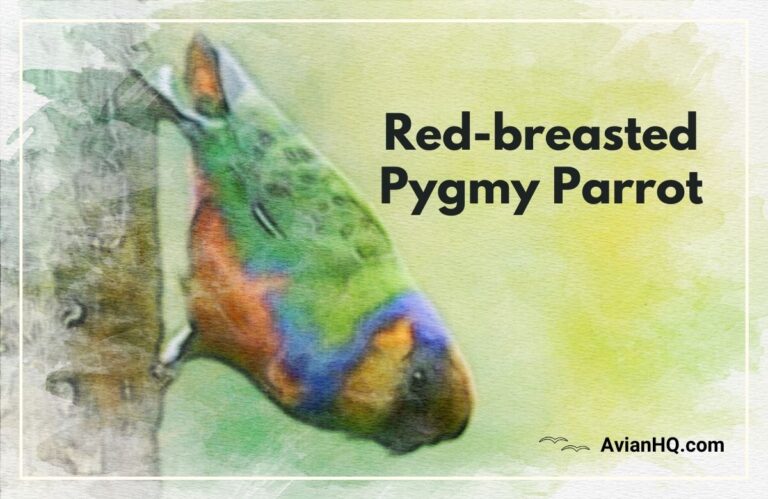Geelvink Pygmy Parrot (Micropsitta geelvinkiana)
The Geelvink Pygmy Parrot is a tiny and colorful bird endemic to a few small islands in Indonesia. With an average body length of only 9-10 cm and weighing a mere 13-17 grams, it is one of the smallest parrots in the world. This diminutive parakeet exhibits beautiful plumage in shades of green, blue, yellow, and brown. Two subspecies exist, each with slightly different color patterns and isolated populations on different islands.
The Geelvink Pygmy Parrot can be found fluttering through lowland forests and rural gardens, foraging for lichens, fungi, seeds, fruits, and insects. Despite it’s small stature, this little parrot has a huge personality and plenty of lively energy.
Learning about the taxonomy, appearance, habitat, ecology, and conservation status of this charming bird provides a window into an exotic corner of Indonesia’s diverse avifauna.
History and Taxonomy
The Geelvink Pygmy Parrot was first scientifically described in 1863 by German naturalist Gustav Hartlaub, who named the species Micropsitta geelvinkiana after Geelvinck Bay in New Guinea. The genus name Micropsitta refers to the bird’s tiny size, from the Greek words mikros meaning “small” and psittakos meaning “parrot.”
This species has two recognized subspecies:
- M. g. geelvinkiana – The nominate subspecies found on Numfor Island, off the western coast of New Guinea. This population was the one originally described.
- M. g. misoriensis – Named for Misool Island, it is endemic to Biak Island, just northwest of Numfor.
The Geelvink Pygmy Parrot measures only 9-10 cm (3.5-4 inches) in length and weighs an astonishingly light 13-17 g (0.5-0.6 oz). The two subspecies differ slightly in their plumage. Males of the nominate M. g. geelvinkiana have more extensive brown on the head and lack a yellow nape patch, while M. g. misoriensis males have a yellow mark on the nape. Females of both subspecies look similar with generally less brown on the head.
Physical Appearance
The plumage of the Geelvink Pygmy Parrot is predominantly green, with striking blue and yellow highlights. The two subspecies have slightly different color patterns.
Male M. g. geelvinkiana have a brown forehead, cheeks, and ear coverts, with some feathers edged in dark blue. The crown and area around the eyes is a deep purple-blue, bordered by a yellow patch on the rear of the head. The throat and foreneck sides are blue, with an orange-yellow breast and green abdomen. The central tail feathers are blue, while the outer feathers are greenish-black. The bill is gray and eyes are brownish-red.
Females have a paler brown face and lack the yellow occipital patch. Their underparts are mostly greenish-yellow.
M. g. misoriensis males have a darker brown head with a blue border on the hindneck and yellow nape mark. Females look similar but lack the yellow nape patch and have faint blue edging on some crown feathers.
In juveniles, the bill is pale yellow tipped with gray-brown. Legs and feet are typical for parrots, with zygodactyl toes for grasping and climbing.
Habitat and Distribution
The Geelvink Pygmy Parrot is endemic to just two small islands off the coast of western New Guinea:
- M. g. geelvinkiana is restricted to Numfor Island in Geelvink Bay
- M. g. misoriensis occurs only on Biak Island, also in Geelvink Bay
These islands have a total land area of only about 3,000 sq km (1,160 sq mi). There are no introduced or captive populations of this species elsewhere in the world.
This parrot inhabits lowland forests, secondary growth forests, cultivated areas with scattered trees, and rural gardens. It has been recorded up to elevations of 400 m (1,300 ft), but is most common below 300 m (980 ft).
On Biak and Numfor, suitable forest habitat is threatened by commercial logging and the expansion of small-scale farming by indigenous communities. However, large tracts of interior forest remain, especially in the mountainous interior of Supiori Island.
Diet and Feeding
The Geelvink Pygmy Parrot is omnivorous, feeding on a variety of plant material and small animals. it’s diet likely consists of:
- Lichens and fungi – scraped off the surface of trees and branches
- Seeds and fruits – plucked from trees and shrubs
- Flowers – nectar and pollen
- Insects – adults, larvae, eggs, and pupae
This tiny parakeet uses it’s slim, pointed bill to pry open fruits and seeds. It can hang acrobatically from branches to collect lichens and look for insects. The tongue has a brush-like tip for laping up nectar.
Geelvink Pygmy Parrots are most often seen foraging in small groups of 4-5 individuals. They carefully climb through branches and foliage in search of food. Their excellent vision and dexterous feet allow them to move effortlessly among the trees.
Breeding and Reproduction
Relatively little is known about the breeding habits of the Geelvink Pygmy Parrot in the wild. The breeding season is believed to run from June to August.
Nests are made in the cavities of arboreal termite mounds, often located just a few meters off the ground. In one observed case, the nest chamber measured approximately 12 cm (5 in) across and 7 cm (3 in) high. The entrance tunnel winds through the termite mound leading to the inner cavity.
Clutch size has not been conclusively documented, but is presumed to be around 2 eggs based on other small parrots. The eggs are incubated for an unknown period of time, likely 20-25 days. Nestlings fledge at an undetermined age, probably 5-7 weeks after hatching.
Adult Geelvink Pygmy Parrots remain close to the nest site to care for fledglings. Their high-pitched contact calls allow parents and chicks to keep in touch.
Behavior and Ecology
The Geelvink Pygmy Parrot is usually quite shy and elusive. It is most often observed in small groups of 4-5 individuals foraging quietly in low vegetation.
Roosting occurs in the dense tangles of forest trees and shrubs. Pygmy parrots prefer to sleep in cavities or hidden amongst epiphytes and thick foliage where they are well concealed from predators.
For much of the day, these tiny parrots carefully clamber through branches searching for food. They use their slim pointed bill to probe into crevices and holes looking for tasty treats. Strong feet allow them to hang upside down when needed.
Geelvink Pygmy Parrots may associate with other small bird species while foraging, such as Australasian warblers. However, they do not form large mixed flocks.
When threatened, these diminutive parrots sit very still, relying on camouflage, before rapidly fleeing while uttering high-pitched alarm calls. Their excellent vision and maneuverability through the trees helps them evade danger.
Conservation Status
The Geelvink Pygmy Parrot is currently classified as Least Concern on the IUCN Red List of Threatened Species. it’s total population size is unknown but presumed to be stable with no evidence of rapid decline.
However, it’s small native range and ongoing habitat loss are causes for concern. The islands of Biak and Numfor have experienced extensive logging and agricultural expansion in recent decades. Remaining suitable forest habitat continues to decline.
The Geelvink Pygmy Parrot is listed on Appendix II of CITES, regulating international trade to avoid overexploitation. It also receives some protection through it’s occurrence in nature reserves on Biak and Numfor islands.
Expanded habitat protection and sustainable forest management will be important for the long-term survival of this endemic species. Ecotourism focused on birdwatching may provide increased economic incentives for conservation.
Cultural Significance
To the indigenous inhabitants of Biak and Numfor islands, the Geelvink Pygmy Parrot has likely been a familiar sight for generations. However, specific folklore or traditional uses for this species are not well documented.
The local people may have native names for this small parrot in their languages and value it’s beautiful plumage. Hunting pressure does not appear to be a major threat at this time.
Ecotourism focused on birdwatching continues to grow in popularity in the region. Visitors hope to catch a glimpse of this endemic parrot along with numerous other exotic bird species. This provides potential economic incentives for conservation of remaining habitat.
Further research into the cultural attitudes, indigenous ecological knowledge, and local folklore regarding the Geelvink Pygmy Parrot could provide valuable insights. The relationship between local communities and wildlife remains deeply connected in this biodiverse corner of Indonesia.
Conclusion
In summary, the Geelvink Pygmy Parrot is a diminutive and colorful endemic bird restricted to just a few small islands in Indonesia’s West Papua region. With a total length of only 9-10 cm (3.5-4 in) and weight of 13-17 g (0.5-0.6 oz), it lives up to it’s name as one of the world’s smallest parrots. This little parakeet inhabits lowland forests and gardens, feeding on a diverse diet of fruits, seeds, nectar, and insects.
Outstanding questions remain about it’s breeding ecology, behavior, and population status. Habitat loss is an ongoing threat across it’s tiny global range. Increased research and habitat protection can help ensure the persistence of this rare species into the future.
The Geelvink Pygmy Parrot provides a window into Indonesia’s unique biodiversity and the conservation challenges faced by many endemic island species.







